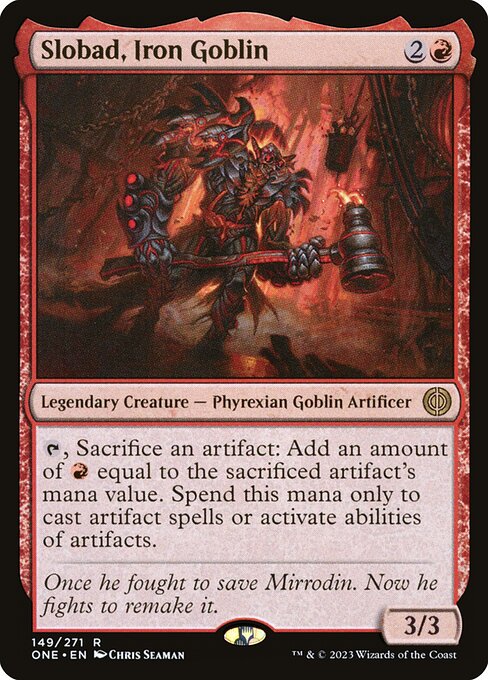
Image courtesy of Scryfall.com
Tracing the Artifact Mechanic from sparks to a sustainable engine
Slobad, Iron Goblin drops us into a world where red’s appetite for disruption meets the gleam of polished metal. This legendary creature from Phyrexia: All Will Be One is a rare that wears its mechanic on its sleeve: a tapped ability that converts artifacts into red mana, but with a careful twist. You sacrifice an artifact to generate mana of red equal to the sacrificed artifact’s mana value, and you may only spend that mana to cast artifact spells or activate artifact abilities. It’s a tight, design-forward engine that embodies the red-blacksmith ethos of Mirrodin—fire, forge, and a bit of reckless genius. The card itself is a 3/3 for {2}{R}, a modest body that becomes something far more exciting once you lean into artifact synergies. And yes, the flavor text anchors it: “Once he fought to save Mirrodin. Now he fights to remake it.” 🧙♂️🔥
Origins: why artifact mana found a home in red
Magic’s history is peppered with artifact-centric themes, from the colorless, all-in acceleration of the early mana rocks to the more deliberate, tempo-oriented plays of red. Slobad’s ability formalizes a long-running idea: you can fuel your spellpower by giving up resources you’ve generated. In the broader arc of MTG design, this is the pivot point where “mana rocks” stop feeling like mere accelerants and become part of a feedback loop. Slobad’s engine emphasizes mana value as a currency—an often-overlooked stat that captures how much “oomph” a card brings to the board. In a sense, Slobad personifies the redsmith’s creed: every artifact has a story, a price, and a potential spark that can be unleashed when the forge is hot enough. 🎨💎
Slobad’s role in gameplay: building around the sacrifice-and-spend constraint
What makes Slobad so compelling is not just what the mana can buy, but what it can’t. The restriction—you can only spend the mana on artifacts—forces a strategic discipline that rewards careful deck construction. You’ll want a steady stream of artifacts to sacrifice, but you also need them to be worth sacrificing in the first place. Cards with high mana value (MV) become especially valuable, because sacrificing a big artifact yields a correspondingly large red payoff. That means your artifact suite should include both inexpensive accelerants (think rocks that generate colorless mana) and some centerpiece artifacts with meaningful MV that can drive late-game plays. It’s a clever dance of tempo and value, where every sacrifice sets up a future spell or ability that tilts the battlefield in your favor. And yes, the synergy is fertile for commander formats where Slobad can be piloted as a tough, golly-gear engine. ⚔️🧰
Because Slobad is a Phyrexian goblin artificer, he also invites the messy, flavorful chaos of Mirrodin’s forge-born society. The flavor text reinforces this sense of ongoing transformation—he once fought to save Mirrodin, now to remake it. The design invites players to imagine a red-forge chain reaction: sacrifice a scrapheap of artifacts, recycle their vitality into raw red mana, and then unleash an artifact-centric capstone that changes the board state. It’s a thematic bundle that resonates with both nostalgia for classic artifact strategies and excitement for new, self-contained engines. 🔥⚙️
Strategic considerations: how to evolve a deck around Slobad
- Artifact density matters: more fodder means more fuel and more potential for explosive turns. Include low-cost artifacts to seed your board early, then ramp into larger, MV-rich pieces that can be sacrificed for bigger red mana bursts.
- Mana value planning: since the payoff scales with MV, reward artifacts that push your total MV higher. This creates a natural arc—early ramp, mid-game sacrifice engines, and late-game red mana storms that let you cast heavy artifact plays with surgical precision.
- Artifact synergy over raw power: Slobad rewards the “artifact-first” archetype. Don’t fight the mechanic; align your curve with artifacts that contribute board presence or utility beyond mana alone (equipment, creatures with ETB effects, or pumps that survive Sacrifice fodder).
- Color and utility constraints: the mana you generate is red and restricted to artifacts. Plan your curve so that your most impactful spells or abilities are artifact-based, maximizing the value of each sacrificed asset.
- Compatibility with broader artifact synergies: this strategy shines in environments heavy with artifact tokens, “treasure” strategies, or artifact-centric payoffs. Slobad becomes the bridge between ramp and payoff, a classic red engine with a modern twist. 🎲
In practice, you’ll see players weaving Slobad into decks that push a “sacrifice to advance” tempo. It’s not about raw speed; it’s about a resilient, craft-driven rhythm where each sacrifice feels earned and each red mana spent feels intentional. The mechanic’s evolution—from simple, generic mana acceleration to a surgical, MV-driven engine—reflects a broader shift in MTG design: empower color to support durable, theme-driven archetypes while maintaining a sense of risk and reward. The scar of the forge—Slobad’s 3/3 frame—belies the magnitude of what you can accomplish when you lean into the craft. 🧙♂️💎
collectors and players who treasure the artistry of MTG will appreciate Chris Seaman’s illustration that brings Slobad to vivid life. The artwork anchors a card that, while modest on the battlefield, offers a rich playground for fans who love pure artifact synergy and the lore of Mirrodin’s ever-evolving forge. It’s the kind of design that invites you to retell the story of how artifacts became more than tools—they became drivers of red-hot ambition. 🎨⚡
Neon Phone Case with Card Holder MagSafe Impact ResistantMore from our network
- https://crypto-acolytes.xyz/blog/post/efficient-minecraft-slime-farming-builds-tips-and-tricks/
- https://crypto-acolytes.xyz/blog/post/compound-finance-and-defi-lending-a-practical-guide-for-investors/
- https://transparent-paper.shop/blog/post/professional-packaging-for-digital-downloads-a-practical-guide/
- https://crypto-acolytes.xyz/blog/post/how-to-choose-the-right-gaming-monitor-for-you/
- https://blog.digital-vault.xyz/blog/post/harnessing-ai-to-discover-tomakul-phoenix-combos/